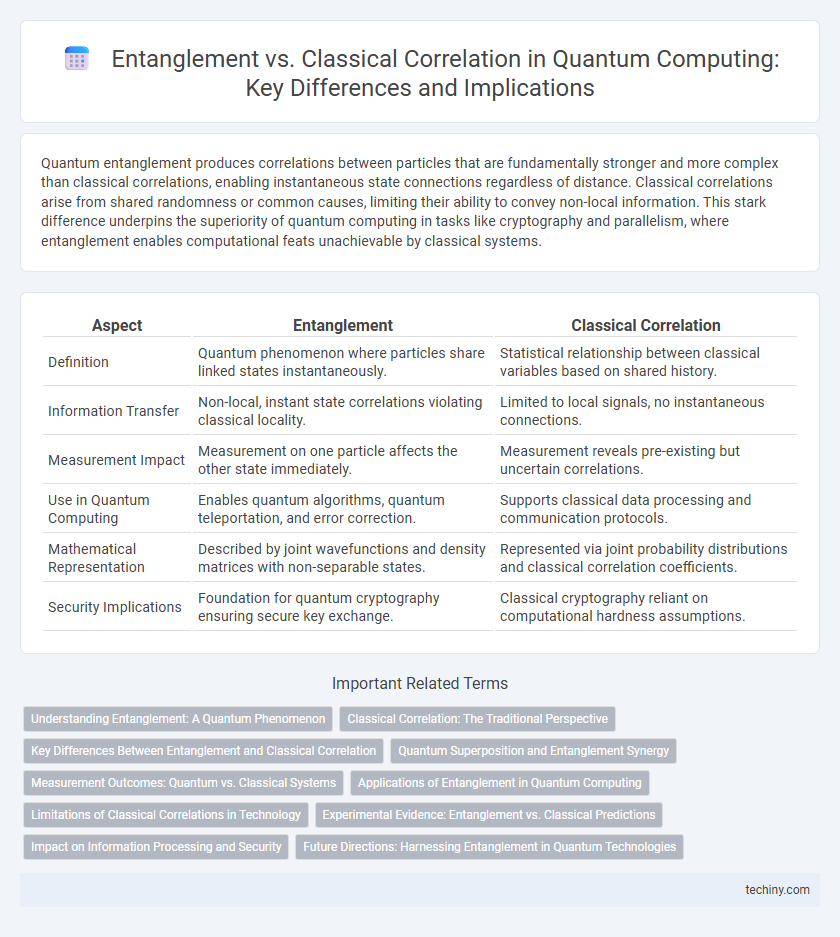Quantum entanglement produces correlations between particles that are fundamentally stronger and more complex than classical correlations, enabling instantaneous state connections regardless of distance. Classical correlations arise from shared randomness or common causes, limiting their ability to convey non-local information. This stark difference underpins the superiority of quantum computing in tasks like cryptography and parallelism, where entanglement enables computational feats unachievable by classical systems.
Table of Comparison
| Aspect | Entanglement | Classical Correlation |
|---|---|---|
| Definition | Quantum phenomenon where particles share linked states instantaneously. | Statistical relationship between classical variables based on shared history. |
| Information Transfer | Non-local, instant state correlations violating classical locality. | Limited to local signals, no instantaneous connections. |
| Measurement Impact | Measurement on one particle affects the other state immediately. | Measurement reveals pre-existing but uncertain correlations. |
| Use in Quantum Computing | Enables quantum algorithms, quantum teleportation, and error correction. | Supports classical data processing and communication protocols. |
| Mathematical Representation | Described by joint wavefunctions and density matrices with non-separable states. | Represented via joint probability distributions and classical correlation coefficients. |
| Security Implications | Foundation for quantum cryptography ensuring secure key exchange. | Classical cryptography reliant on computational hardness assumptions. |
Understanding Entanglement: A Quantum Phenomenon
Entanglement is a uniquely quantum phenomenon where particles become interconnected such that the state of one instantly influences the state of another, regardless of distance, contrasting sharply with classical correlation which arises from shared history or common causes. Unlike classical correlations limited by local realism, entangled particles exhibit nonlocal correlations that defy classical explanations, enabling capabilities like quantum teleportation and superdense coding. Understanding entanglement is essential for advancing quantum computing, as it forms the foundation of quantum algorithms that outperform classical counterparts by leveraging superposition and nonlocality.
Classical Correlation: The Traditional Perspective
Classical correlation describes statistical relationships between variables that can be explained by shared information or common causes within classical physics frameworks. Unlike quantum entanglement, classical correlations do not exhibit nonlocality or the ability to violate Bell inequalities, limiting their capability to enable phenomena such as superdense coding or quantum teleportation. Traditional perspectives view classical correlation as a tool for understanding probabilistic dependencies without harnessing the unique features of quantum mechanics.
Key Differences Between Entanglement and Classical Correlation
Entanglement in quantum computing represents a unique correlation where the quantum states of particles become interdependent, exhibiting non-local properties that classical correlation cannot achieve. Unlike classical correlation, which arises from shared information or common causes, entanglement enables instant state determination regardless of distance, defying classical causality constraints. This fundamental difference underpins quantum advantage in qubit-based algorithms, quantum cryptography, and information processing, distinguishing quantum systems from classical probabilistic models.
Quantum Superposition and Entanglement Synergy
Quantum superposition enables qubits to exist in multiple states simultaneously, forming the basis for entanglement where quantum states become intrinsically linked across particles. Unlike classical correlation, which relies on shared information or hidden variables, entanglement exhibits non-local connections that cannot be explained classically. This synergy between superposition and entanglement powers quantum algorithms by enabling exponentially enhanced computational parallelism and stronger correlation patterns beyond classical limits.
Measurement Outcomes: Quantum vs. Classical Systems
Measurement outcomes in quantum entanglement exhibit nonlocal correlations that cannot be explained by classical probability theory, as entangled particles instantaneously affect each other's states regardless of distance. Classical systems rely on shared random variables to produce correlated results, but these correlations diminish with increasing system separation and can be fully described by local hidden variable models. Quantum measurement outcomes violate Bell inequalities, demonstrating stronger-than-classical correlations unique to entangled states and foundational for quantum communication and cryptography.
Applications of Entanglement in Quantum Computing
Entanglement enables quantum computers to perform complex computations exponentially faster than classical systems by linking qubits in ways that classical correlation cannot replicate. Applications such as quantum teleportation, superdense coding, and error correction protocols rely on entangled states to transmit information securely and enhance computational accuracy. This unique quantum resource powers algorithms like Shor's factoring and Grover's search, demonstrating superior performance over classical counterparts.
Limitations of Classical Correlations in Technology
Classical correlations, constrained by local realism, cannot replicate the non-local properties exhibited by quantum entanglement, limiting their effectiveness in advanced technological applications such as quantum cryptography and quantum teleportation. These classical correlations fail to provide the exponential speedup and secure information transfer enabled by entangled quantum states. Consequently, reliance on classical correlations restricts the development of scalable quantum networks and hampers the progression of quantum computing capabilities.
Experimental Evidence: Entanglement vs. Classical Predictions
Experimental evidence consistently demonstrates that entanglement in quantum computing produces correlations that violate classical predictions, as seen in Bell test experiments with photons and ions. These results confirm quantum nonlocality, showing measurement outcomes that cannot be explained by any local hidden variable theory. Such empirical data solidifies entanglement as a fundamental resource enabling quantum algorithms and secure quantum communication protocols beyond classical limits.
Impact on Information Processing and Security
Quantum entanglement enables instantaneous correlations between qubits that classical correlations cannot replicate, dramatically enhancing information processing capabilities by enabling quantum algorithms like Shor's and Grover's to outperform classical counterparts. Entanglement-based protocols such as Quantum Key Distribution (QKD) provide provably secure communication channels resistant to eavesdropping, unlike classical correlations which are vulnerable to interception and replication. This fundamental distinction elevates quantum computing beyond classical limits, driving advances in cryptography, secure communications, and complex problem-solving.
Future Directions: Harnessing Entanglement in Quantum Technologies
Future directions in quantum technologies emphasize harnessing entanglement to achieve computational and communication advantages unattainable by classical correlation. Quantum entanglement enables phenomena such as secure quantum key distribution and quantum teleportation, which drive innovation in quantum networks and distributed computing. Advancements in entanglement generation, manipulation, and error correction are crucial for scaling quantum systems and realizing practical quantum advantage in fields like cryptography and materials science.
entanglement vs classical correlation Infographic

 techiny.com
techiny.com